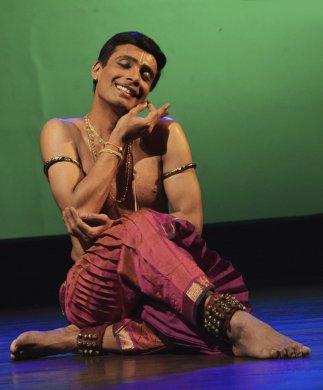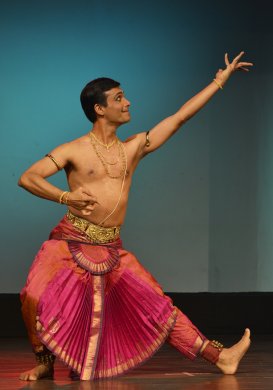
|   |

|   |
Stardom beckons him - Jyothi Raghuram e-mail: jyothi.r.ram@gmail.com January 20, 2019 To describe a long-time dancer as a rising star wouldn't quite be in the fitness of things; nor is it fair to say the dancer has honed his skills, when, in reality, the person in question is a performer, teacher, with the tag of a popular itinerant dancer for overseas productions. Years of experience may bring a degree of confidence, inadequate especially to sustain as a soloist, more so if a male dancer.  The metamorphosis didn't certainly develop overnight; unaffected and sustained application paid off as a satisfying outing, with heartwarming, effective communication. The Bharatanatyam recital under review is that of Dr. Seshadri Iyengar at the ADA Rangamandira, Bengaluru, recently, as part of the annual VRC Music and Dance Festival. The biggest challenge to a male soloist is traversing the gender roles with certitude, effeminate characterization being a major pitfall in the process. The overt sringara in the Kharaharapriya varnam, Moham Aaginen, was sensuous without being bawdy, the lovelorn nayika's yearning for Lord Shiva actuated on stage naturally, showing that dance goes far beyond the concept of gender vis a vis a male soloist - a singular, creditable distinction of Seshadri's recital.  Chandrashekharam Bhajaami Satatam, a keerthanam in ragam Chandrakauns extolling Ishwara with its thrust on nritta, was enlivening, without overdoing the clichéd tandava aspect. Guru Padmini Ravi's visualization of Shiva, the supreme dancer, without the shop-soiled frills of depiction, was a test of the dancer's machismo, demanded by his gender, which he put forth only through the strength of his nritta. The contrast and balance of portrayal in the varied pieces complemented by his stage demeanour, made Seshadri an exceptional communicator -- a crucial element lost in many a solo recital today, resulting in a soulless outing. In this, Seshadri stands distinguished as a soloist who can sustain audience interest, carrying them along with him in a symbiotic oneness of feeling. Earlier, Jagdodhaarana (kapi) encapsulated all this, the dance composition juxtaposing the irony of Lord Krishna, the creator of the universe, being cajoled by mother Yashodha to eat, by showing him the moon and the stars, her wiping the sweat off his face when he is purity personified, and his omnipresence ranging from a particle of dust to the entire universe, exemplified through the Vamana and Narasimha avataras, with convincing sancharis. The entire aesthetics of his dance including his tidy nritta, culminated in an emotional experience, the concluding bhajan Achutam Keshavam (Bilawal Thaat) resounding with the consciousness of divinity. Seshadri's recital effectively set aside the general misconceptions and preconceived notions about the limitations of male soloists. His costume and make-up needed uplift. Padmini Ravi's impeccable nattuvangam, indeed her very presence, added to the solidity of the show. Vocalist Neela Ramanuja was more a crooner that evening. Sri Hari (mridangam) and Narasimhamurthy (flute) lent able support. Jyothi Raghuram is a senior journalist and an art critic. |